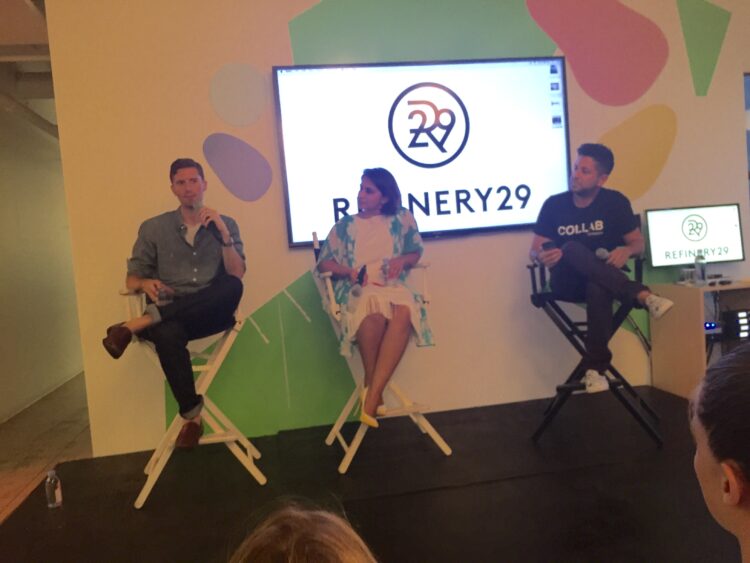
The room was packed at Refinery 29’s trendy downtown office for The Influence: Technology and Fashion, hosted by Startup Weekend’s Global Fashion Battle and Open Source Fashion. Fashionistas and entrepreneurs gathered to enjoy wine, cheese, and mini cupcakes while networking and getting to know who in Silicon Alley is paving the way in the fashion and tech scene.
Andrew Young of Startup Weekend NYC kicked off the evening with an overview of what Startup Weekend is and details of this year’s Global Fashion Battle, where winners of the weekend hackathons in NYC, London, Chicago, Miami, Guadalajara, and Santa Cruz, Bolivia will be flown to Poland to present to judges at the Art and Fashion Forum. We heard from some of last year’s battle’s success stories as well.
The main event was a panel featuring Frank Conway, VP of Product Development, and Benish Shah, Director of Product Marketing, both at Refinery 29, and was moderated by the humorous and refreshingly candid Pavan Bahl, founder of Open Source Fashion. The panel was entertaining as it was informative about Refinery 29, the lifestyle company that has become the “go-to” source of information for millennial women on fashion, love, beauty, health, entertainment, and wellness. In fact, it’s 36 million women that have come to love and trust the brand. And that’s per month. They now publish 75-100 new articles per day.
Shah and Conway shared insight into the company and the data the drives it, plans for the future, and why the brand is so irresistible to many of us. We also learned about their new influencers network, Here and Now. Shah explained that this is just formalizing Refinery’s longstanding relationship with many bloggers and social media celebrities, using their platform in a new way towards a similar end.
As for their secret sauce, Conway explained that data drives their content and really everything they do. Their internal analytics system, called Dash, guides their content and design towards optimizing the “Refinery gal’s” experience with the brand as well as provides predictive analysis. Conway explained that while other companies can copy their product and content, they won’t have their data. They are constantly A/B testing their homepage and curated content. Bahl even explained that an article on wayfarers appeared on his Refinery homepage, and despite the story being a month old, their data knew that he loves his wayfarers. Their emails, however, are not data driven or technical.
Shah chimed in that their data is also driven by their unusually high amount of touch points with their readers. Every three weeks Refinery brings in actual readers to their office to glean insights into their content and user experience. This drives the content of their editorial teams, as everything is created and produced in house.
Refinery 29 focuses heavily on the user experience, even in the details of which share buttons it features on its site. Conway explained that it’s important to tailor the experience to the medium you are on, so while their desktop website features Facebook, Pinterest, and email options to share a story, their mobile experience is tailored towards just that and has texting options as well.
Bahl also asked the panelists about their motivations behind their new tinder-like features called Rad or Bad where users have to swipe through different products or photos and share their thoughts. Conway explained that it is a new way to express content that isn’t an article or slideshow, and also an additional source of data, adding a new layer of understanding to their readership. The data is used for strategy as well as to bring back to their brand partners to understand what a Refinery gal loves (or hates!) to inform product development. Ain’t that rad?
Overall the evening was fun, high energy, and we all indulged in plenty of laughs while learning from one of NYC’s fastest growing online publications. For me, the night’s biggest takeaway was the focus on using data and metrics, as well as in person interviews, to truly understand your customer. By doing so, you are creating a product that customer truly wants, needs, and finds interesting. And that’s what keeps them coming back for more.



